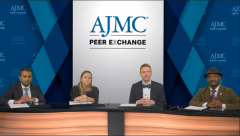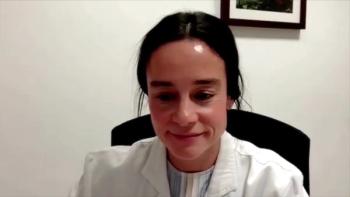
Preferred Treatment Sequencing for Patients with MM
In the final discussion, expert panelists navigate treatment sequencing in MM treatment strategies.
Episodes in this series

Ryan Haumschild, PharmD, MS, MBA: Dr Thertulien, I’ve got a question for you in regard to sequencing. When we’re communicating with our academic and our community partners, it’s always important to think outside of the initial regimen and sometimes give guidance on sequencing. And sequencing doesn’t mean it has to be product specific all the time, but sometimes it can be a preferred product or recommended products based on how a patient is progressing through their therapy. My question to you all is are you sequencing treatments first, second, and third line in your pathways, and what does a preferred sequence look like in multiple myeloma?
Raymond Thertulien, MD, PhD: That’s an excellent question, but also a very challenging question. That’s the type of question where you put 10 myeloma physicians together and you’ll get 100 answers. That is reflected, in fact, in the guidelines when you look at them, we mentioned that earlier once you are past the first line. In the United States it’s almost clear cut that we use RVd [lenalidomide, bortezomib, dexamethasone], for transplant-eligible patients, we use RVd for transplant-ineligible patients. We use dara [daratumumab]-RVd quadruplet for high-risk patients, and we use DRd [daratumumab, lenalidomide, dexamethasone]for transplant-ineligible patients. These are the most commonly used regimens in the first line. Once you get to the second line, that’s when you start having divergence because we are living in a time of plenty. The ability to determine which is the best regimen at which line of therapy is the challenge in multiple myeloma because we don’t have a lot of data to guide us as to which regimen should come in the second line and which regimen should come immediately after that for third and fourth line.
Therefore, each of us myeloma physicians, we develop a certain comfort with certain regimens that we use for certain patients based on a lot of factors. There are patient factors, obviously, that we mentioned already in terms of what we think the patient can tolerate, and the frailty of the patient. We choose regimens based on safety, what type of comorbidities the patient has, and what we think they can tolerate in terms of the adverse effects of that particular regimen. And obviously, which type of drugs the patient hasn’t seen before, and which type of disease we’re dealing with. Is this patient relapsing with the same initial disease they had in terms of cytogenetics, or [when you look at the] bone marrow all of a sudden you see a TP53 mutation, or high-risk cytogenetics, or ultra high-risk cytogenetics, in the relapsed setting? That will inform what you will choose in the second line and in subsequent lines.
Most of the regimens that we use in second, third, and fourth line are agnostic to risk. Because a lot of the patients involved in those trials had all kinds of cytogenetics, but we do choose on the basis of these factors. As Dr Lipe mentioned before, at each line of therapy, we try to choose a regimen that will give us the best response, the best progression-free survival, that eventually will translate into an overall survival benefit for the patient because they are the 2 things we are working for in multiple myeloma. It’s 1, we want our patients to live longer, and 2, we want our patients to have a great quality of life. So, whenever we’re choosing a regimen, whether it’s second, third, fourth line, we must always have these 2 end points in our mind. And Dr Lipe mentioned that earlier, we have a lot of regimens. I don’t know how many you said, 12, 13 regimens listed in the NCCN [the National Comprehensive Cancer Network guidelines]. That gives you margins, that gives you options to choose a regimen that you feel is efficacious but also will provide that quality of life in addition to control of disease for that patient.
Ryan Haumschild, PharmD, MS, MBA: Well said. [There are] lots of options. You’ve got to take in those patient-specific factors. Also, where is that emerging data going, and then sequencing from there means that, yes, you might have a sequence, but it’s not going to be the same for every patient, and it gives you room for selection. I appreciate that. That was a great summary. Before we conclude, I have 1 more question for Dr Nadeem, and it’s around our community partners. I know they’re involved in some of these discussions, you have to have a representative. But also, with so much emerging data not just in multiple myeloma but diffuse large B-cell [lymphoma] and all these other different areas in the hematological diseases, how do you make sure you’re educating providers about the pathways in multiple myeloma? Do you rely on the EMR [electronic medical record] to help give a lot of that direction? Are there any other tactics to make sure that they understand how it’s being utilized? Dr Lipe mentioned, not just looking at the clinical trial, but also now looking at modern practice and how we’re extrapolating those results to the real world.
Omar Nadeem, MD: As I mentioned earlier, it happens in so many different phases. We all do a lot of talks and forums where we have a lot of discussions with providers around the area or other parts of the country, where you’re able to have some case presentations and discussions about how you would manage or think about a certain scenario. I hope those are helpful to folks who are participating in those to have a back-and-forth discussion. Sometimes it’s very difficult to just look at a paper and say, “OK, well this regimen was better than that one in this trial,” and know all the data. But in the end, when you’re dealing with a particular case, there are so many nuances in myeloma that it is really difficult without having an actual conversation about it. That’s one forum. There are a lot of informal discussions every time I get a call about a particular patient. Then there’s always a second and third and fourth question after that’s not about the patient. “What are you guys doing with this? What are you guys doing with this?” That’s exactly how I think a lot of information is now disseminated, you see it, and then you want to get some input from people who are treating myeloma regularly, and how are they incorporating some of those changes into their treatment guidelines?
Then there are the big conferences like ASH [the American Society of Hematology annual meeting], and those forums are always good for new data presentations and interactions. I interact with so many of my colleagues there every year to have some of these discussions. So there are many different ways to do it. I think now with a lot of information that’s so readily available, everybody gets the same information at the same time. Then I think it argues for nowadays more than ever, particularly in the virtual world, to be able to have some of these discussions more regularly without a lot of travel or inconvenience on anyone’s part because everybody is so busy. But I think that’s where some of the keys are in terms of having those discussions.
Ryan Haumschild, PharmD, MS, MBA: Excellent. It’s like having the playbook in the EMR, educating around it, having those one-off conversations. That’s the best way to drive change and adoption in your practices.
Thank you. And to our viewing audience, we hope you found this American Journal of Managed Care® Peer Exchange to be rich and informative.
Transcript edited for clarity.
Newsletter
Stay ahead of policy, cost, and value—subscribe to AJMC for expert insights at the intersection of clinical care and health economics.









































